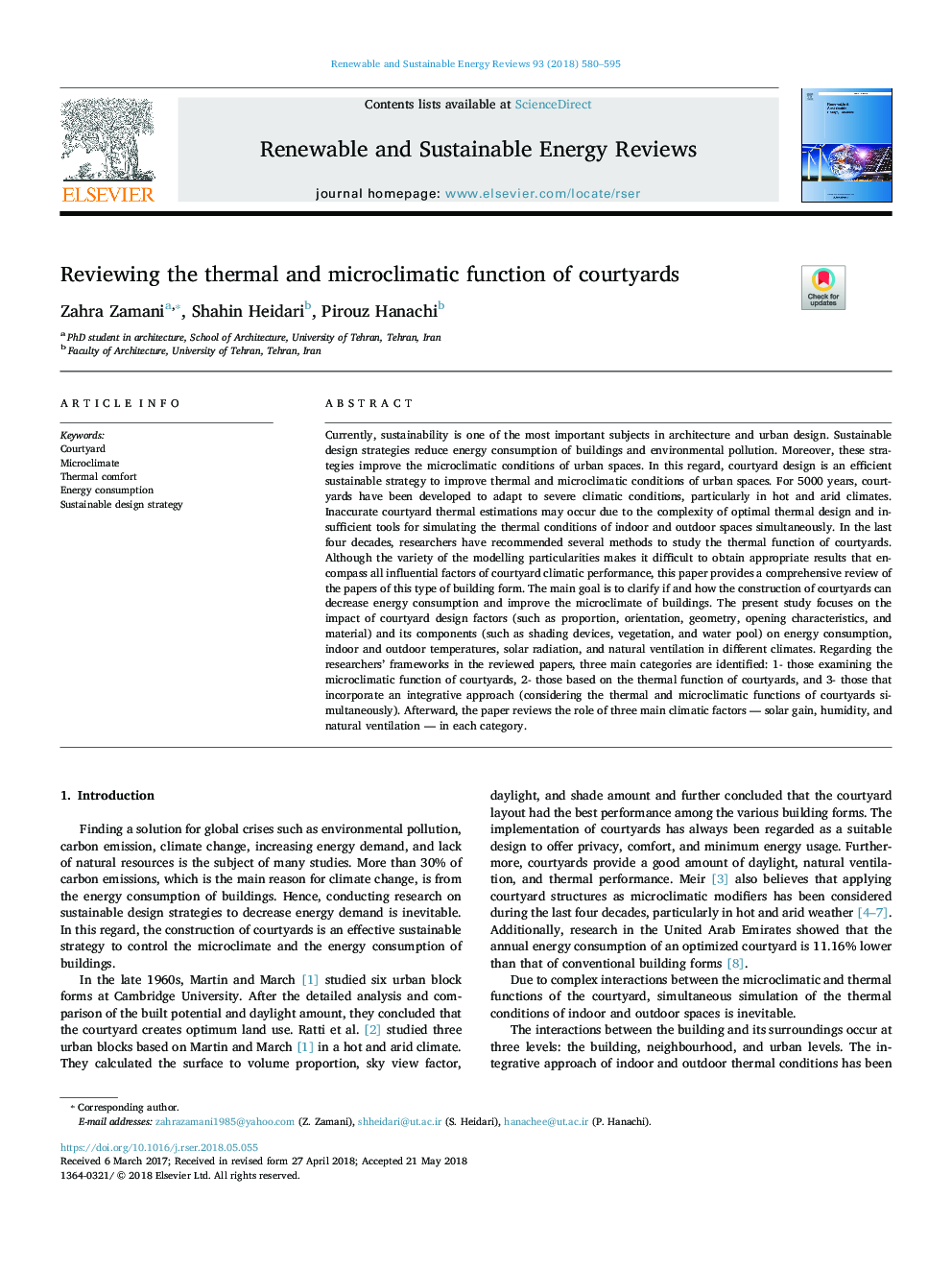| کد مقاله | کد نشریه | سال انتشار | مقاله انگلیسی | نسخه تمام متن |
|---|---|---|---|---|
| 8110757 | 1522291 | 2018 | 16 صفحه PDF | دانلود رایگان |
عنوان انگلیسی مقاله ISI
Reviewing the thermal and microclimatic function of courtyards
ترجمه فارسی عنوان
بررسی عملکرد حرارتی و میکرو کالیسیتی حیاط
دانلود مقاله + سفارش ترجمه
دانلود مقاله ISI انگلیسی
رایگان برای ایرانیان
کلمات کلیدی
حیاط، میکرو کلم راحتی حرارتی، مصرف انرژی، استراتژی طراحی پایدار،
ترجمه چکیده
در حال حاضر، پایداری یکی از مهمترین موضوعات در معماری و طراحی شهری است. استراتژی های طراحی پایدار کاهش مصرف انرژی ساختمان ها و آلودگی محیط زیست را کاهش می دهد. علاوه بر این، این استراتژی ها شرایط میکرو کلاسیک فضاهای شهری را بهبود می بخشد. در این راستا، طراحی حیاط یک استراتژی پایدار کارآمد برای بهبود شرایط حرارتی و میکرو کلاسیک فضاهای شهری است. برای 5000 سال، حیاط ها برای انطباق با شرایط آب و هوایی شدید، به ویژه در آب و هوای گرم و خشک توسعه داده شده است. تخمین های حرارتی حیاط نادر ممکن است به علت پیچیدگی طراحی طراحی حرارتی و ابزار کافی برای شبیه سازی شرایط حرارتی فضاهای داخلی و خارجی به طور همزمان رخ دهد. در چهار دهه گذشته، محققان چندین روش برای مطالعه عملکرد حرارتی حیاط ها پیشنهاد کرده اند. اگر چه تنوع ویژگی های مدل سازی دشوار برای به دست آوردن نتایج مناسب است که شامل تمام عوامل تاثیرگذار از عملکرد آب و هوا حیاط، این مقاله بررسی جامع از مقالات این نوع ساختمان را فراهم می کند. هدف اصلی این است که مشخص شود آیا و چگونه ساخت حیاط ها می تواند مصرف انرژی را کاهش دهد و محیط اطراف ساختمان را بهبود بخشد. این مطالعه بر تاثیر عوامل طراحی حیاط (مانند نسبت، جهت گیری، هندسه، ویژگی های باز و مواد) و اجزای آن (مانند دستگاه های سایه انداز، پوشش گیاهی و استخر آب) بر مصرف انرژی، دمای محیط داخلی و در فضای باز، تمرکز دارد. تابش خورشید و تهویه طبیعی در اقلیم های مختلف. با توجه به چارچوب محققان در مقالات مورد بررسی، سه دسته اصلی شناسایی شده اند: 1- کسانی که در بررسی عملکرد میکرو کلاسیک حیاط ها، 2- آن ها بر اساس عملکرد حرارتی حیاط ها، و 3- آنهایی که یک رویکرد یکپارچه سازی را شامل می شوند (با توجه به حرارتی و عملکرد میکرو کلاسیک حیاط به طور همزمان). سپس مقاله بررسی نقش سه عامل مهم آب و هوایی - افزایش خورشید، رطوبت، و تهویه طبیعی - در هر رده را بررسی می کند.
موضوعات مرتبط
مهندسی و علوم پایه
مهندسی انرژی
انرژی های تجدید پذیر، توسعه پایدار و محیط زیست
چکیده انگلیسی
Currently, sustainability is one of the most important subjects in architecture and urban design. Sustainable design strategies reduce energy consumption of buildings and environmental pollution. Moreover, these strategies improve the microclimatic conditions of urban spaces. In this regard, courtyard design is an efficient sustainable strategy to improve thermal and microclimatic conditions of urban spaces. For 5000 years, courtyards have been developed to adapt to severe climatic conditions, particularly in hot and arid climates. Inaccurate courtyard thermal estimations may occur due to the complexity of optimal thermal design and insufficient tools for simulating the thermal conditions of indoor and outdoor spaces simultaneously. In the last four decades, researchers have recommended several methods to study the thermal function of courtyards. Although the variety of the modelling particularities makes it difficult to obtain appropriate results that encompass all influential factors of courtyard climatic performance, this paper provides a comprehensive review of the papers of this type of building form. The main goal is to clarify if and how the construction of courtyards can decrease energy consumption and improve the microclimate of buildings. The present study focuses on the impact of courtyard design factors (such as proportion, orientation, geometry, opening characteristics, and material) and its components (such as shading devices, vegetation, and water pool) on energy consumption, indoor and outdoor temperatures, solar radiation, and natural ventilation in different climates. Regarding the researchers' frameworks in the reviewed papers, three main categories are identified: 1- those examining the microclimatic function of courtyards, 2- those based on the thermal function of courtyards, and 3- those that incorporate an integrative approach (considering the thermal and microclimatic functions of courtyards simultaneously). Afterward, the paper reviews the role of three main climatic factors - solar gain, humidity, and natural ventilation - in each category.
ناشر
Database: Elsevier - ScienceDirect (ساینس دایرکت)
Journal: Renewable and Sustainable Energy Reviews - Volume 93, October 2018, Pages 580-595
Journal: Renewable and Sustainable Energy Reviews - Volume 93, October 2018, Pages 580-595
نویسندگان
Zahra Zamani, Shahin Heidari, Pirouz Hanachi,
